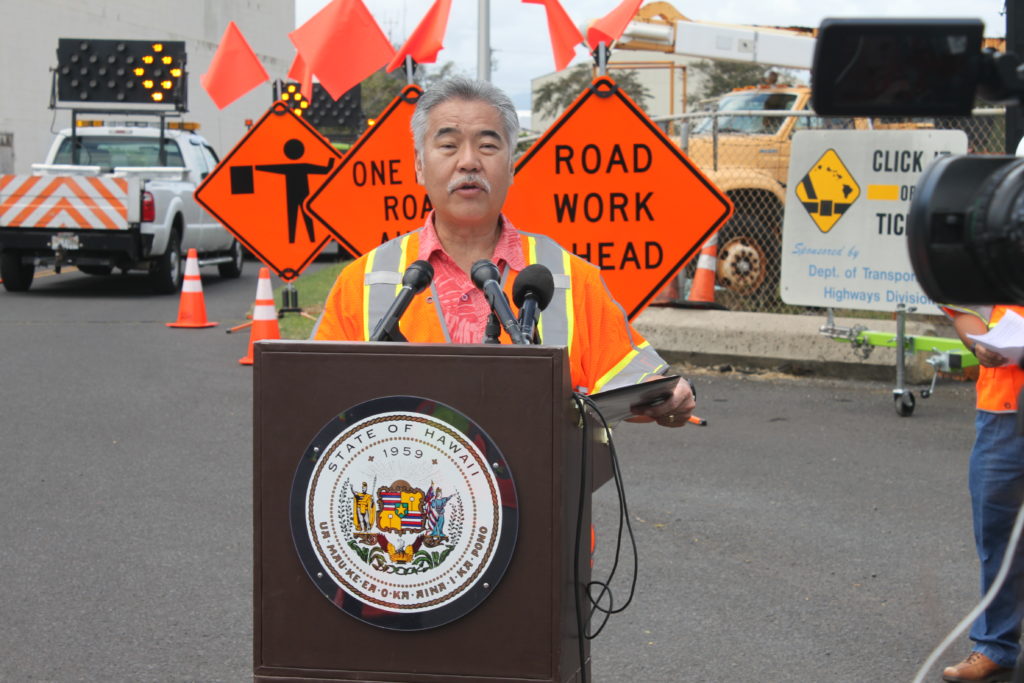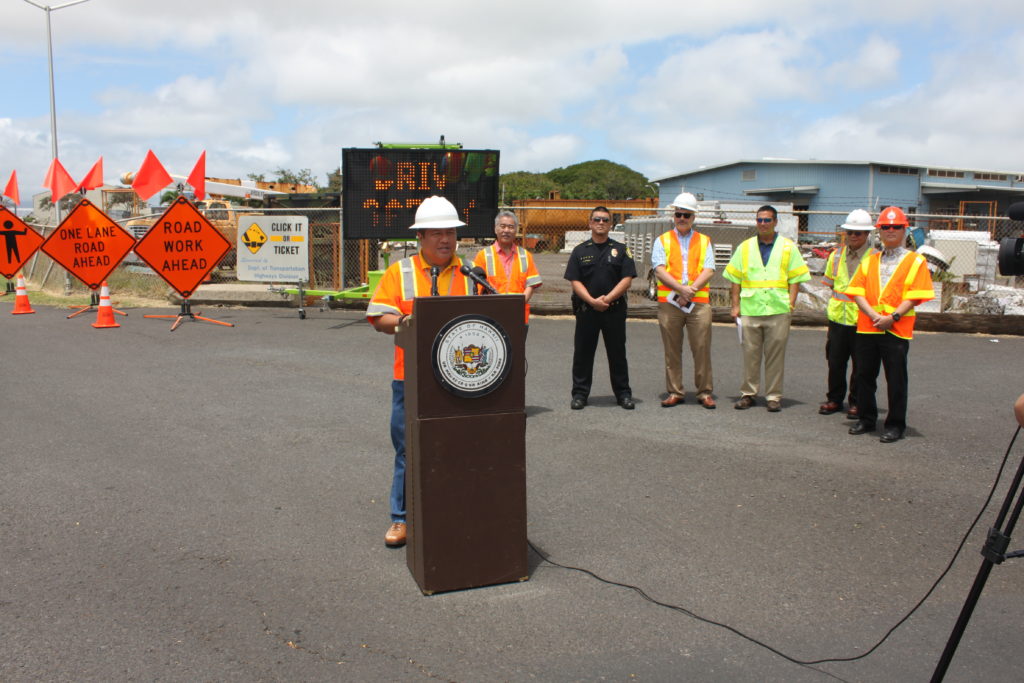HDOT Urges Drivers to Be Aware, Move Over for Workers on the Road
The Hawai‘i Department of Transportation (HDOT) announces that it’s National Work Zone Awareness Week and the HDOT is reminding everyone of the importance of driving safely in all work zones, including construction zones along Hawai‘i’s roads. In honor of the campaign Aloha Tower is illuminated in orange to help spread awareness for the safety messaging.
“Our emergency responders, work crews, and construction workers all have a part in keeping our roadways safe for drivers every day,” said Governor David Ige. “We need to do our part to keep them safe.”

Governor David Ige speaking about the importance of driving safely through work zones so everyone makes it home alive. Courtesy Hawai‘i Department of Transportation
“Each of the past three years, Hawai‘i has suffered three work zone related fatalities,” said HDOT Director Jade Butay. “This year we’ve already experienced one work zone crash resulting in a death. This is a trend that must be reversed.”
National statistics from 2016, the latest year of available data, reveals that 765 people were killed in highway work zone crashes across the country. Many of these deaths could have been prevented if the drivers involved had slowed down and followed construction zone signage.
“We want to make sure everyone understands that there is a reason for construction speed limits and buffer zones,” said HDOT Deputy Director for Highways Ed Sniffen. “The reason is that we want everyone working on our roads to get home safely.”

HDOT Director Jade Butay reports three people have been killed in construction zones each of the past three years in Hawai‘i, thus highlighting the need for drivers to obey posted speed limits and drive with caution through work areas. Courtesy Hawai‘i Department of Transportation.
Major Ryan Nishibun of the Honolulu Police Department Traffic Division highlighted the state’s Move Over law, which requires drivers approaching an emergency vehicle to move over or slow down to a reasonable and prudent speed. Failure to comply with the Move Over law may result in a traffic citation, followed by a mandatory court appearance and up to a $1000 fine.
For more information on the penalties for speeding in a school zone or construction area, click here.
For the full text of the Move Over law, click here.
FAQ regarding Temporary Traffic Control
Why is the lane closure so long when the work zone is so short?
There are various reasons why a given length of roadway is closed, but the main reason is that work is being conducted to maximize productivity. Roadway work is dynamic with several ongoing operations scheduled during a lane closure event. In some cases, like lane striping, painting, landscaping or median improvements, crews may start on one end of the work zone and finish on the other end. For efficiency and safety purposes the entire work area is closed, but it may appear the workers are only in a small area when the driver passes.
It should be noted that the length of the closure has a minimal impact on the traffic delay. The delay typically occurs during the merging/tapering process. Whether a lane closure is a quarter mile or five miles in length, the main impact occurs during the merging transition.
Why are lanes closed when no one is working?
In some cases, it may look like no one is working and the lane closure is not necessary, however not all work is visible. There can be work such as surveying, preparation work, utility relocation or other functions that may not be observed, but still require a lane closure. In addition, crews may have poured concrete or asphalt and a specific time is needed for the product to cure/dry before the roadway is reopened to vehicular traffic.
Why are multiple lanes closed when work is only being done in one lane?
In many cases it is not feasible or safe to conduct operations within the limits of a single lane. Maintaining traffic directly adjacent to a work operation, separated only by a lane stripe is extremely hazardous for both drivers and workers. Longer term projects may use temporary concrete barrier to separate traffic from the work zone. HDOT practice is to close the minimum number of lanes possible, but not at the expense of safety for the public and workers.
Why do you start merging the lane closure so far away from the work zone?
The tapering process is a series of traffic control devices, such as cones, that merges vehicular traffic from one lane into another in a safe and efficient manner. The primary consideration is traffic speed. The higher the speed limit the longer the taper. A freeway lane closure with a 55-mph speed limit would use a 700-foot taper. A highway with a 40-mph speed limit requires a 350-foot taper, or longer than the length of a football field. It may be longer if there are curves or hills in the roadway.
Where can I find more information?
Temporary traffic control measures are designed with safety in mind. For additional information on the regulations that guide traffic control decisions from the Federal Highways Administration, click here.
To view the Hawai‘i Standard Specifications for work zone traffic control, click here.
















